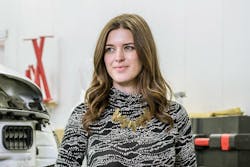ROGER BEASLEY COLLISION
CENTER - NORTH
LOCATION
AUSTIN, TEXAS
SIZE
33,700 SQUARE FEET
STAFF
40
AVERAGE MONTHLY CAR COUNT
250-300
ANNUAL REVENUE
$7.5 MILLION
If you ask Blair Womble what her position is at Roger Beasley Collision Center, She won't have an answer.
That’s probably because, from the front desk to the parts department to the wash rack to the service writing, Womble has pretty much covered everything. Daughter of Dusty Womble, the company’s vice president, she adapts by filling holes in various sectors, moving between the Austin, Texas, shop’s south and north locations and providing relief wherever needed.
Womble has always had a knack for leading teams. For years she’s bounced between California and Texas, managing staff in a variety of settings, from department stores to theater wardrobe departments. Growing tired of her random, late-into-the-night hours, she returned to Roger Beasley Collision three years ago, where she had spent her summer months during high school and had enjoyed a more concrete schedule.
And now that the 31-year-old has finally settled into a managerial role in the company’s 40-employee north location, she’s taking advantage of being able to schedule out her entire day, splitting time between organizing the production schedule, updating the shop’s high-end customers, and hiring for open positions at the company.
We have a meeting with all the service writers, technicians and management staff at 8 a.m. every morning. The meeting runs from 35 minutes to an hour, depending on how many vehicles we have being delivered in the next few days. Our production manager, our owner and myself lead the meeting.
I’ll print off the production list, which I’ve prepared the night before. We go technician by technician, starting in the body department, and discuss all cars in body, paint, reassembly, etc. We’re specifically looking at vehicles that don’t have dates set yet and vehicles due out this week.Then the techs are released.
With the service writers, we go over vehicles that are on-lot, which is anywhere from 170 to 215 cars, that haven’t moved into production yet. We discuss what we are waiting on and supplemental vehicles. It gives the service writers a chance to say, “That car has been here for six days and we still haven’t gotten customer authorization or an insurance estimate. We need to follow up on that.”
Once the meeting is over, I’ll stay back with the production manager and go through what we have due today. We’ll set times for pick-ups, and go over any additional issues that need to be addressed: Do we have a specific hot-case customer that needs to be addressed? Do we have personnel issues we need to talk about?
After the meeting, I come in with the list, and fill out the day’s schedule in CCC ONE, set dates, and then print and pass out a list of vehicles scheduled to be delivered today. If I have insurance adjusters show up or dealerships calling me, this part of the day takes me anywhere from 30 minutes to two or three hours. It all depends on how big the workload is and how much I get pulled away while doing it.
Before lunch, I’m contacting my customers with updates on their vehicles. It may be one or two phone calls a day, just because I like to space them out over the week. I’m overseeing 13 dealerships that feed our shops and handling all of our OEM stuff right now: Audi aluminum, Porsche aluminum, Volvo, Maserati. We’re in the process of getting our Tesla certification. I deal with those customers that fall into those camps.
That’s all high-end stuff, so it’s a different kind of customer. There are less of them, but they require more care. You have to be more verse with the more complicated repair methods and be able to talk to customers about that. They usually want a different kind of attention, meaning we’re either dealing with an assistant, or they’re executives and are in and out of town, in and out of meetings; so it just takes a different approach. We use UpdatePlus through CCC One and send them emails and text messages. That can be especially important with the owners of the exotic and aluminum vehicles who have these crazy, busy lives, who just want to look down at a text message and know what’s going on.
I’ll walk through the shop at least once a day. It’s pretty rare I don’t have to go out and talk to a tech or at least go to the parts department. For the vehicles I specifically work with, it’s usually only one tech I deal with. It’s a tech that’s been here 11 years who we trust with those vehicles. I’ll also talk to our production manager, talk to our parts manager when checking on a specific car.
I try to get all of that taken care of before my 11:30 lunch, before anything else falls in my lap. If I have time in the morning, I will, more than likely, have to make a run to one of the dealerships to deliver a car. If I’m too busy in the morning, I do that in the afternoon.
Organizing my mornings properly is important because the afternoon is my project time. Right now, my project is interviewing and hiring. We used to give résumés to our owner and he would pick who we were going to interview. Now he’s too busy running three businesses. Also, our office manager used to put all of our ads on Craigslist and Monster, but now she’s managing two locations and she has too much on her plate, as well. So I’m trying to offset both of them.
In the mornings, I’ll usually print off any résumés we’ve gotten overnight, and then look them over after lunch. I have a list of job descriptions for positions we have hired in the past or regularly hire for, so I just copy and paste those into ads. And then I’ll look over the résumés that come in and make a phone call for an interview.
Since I’m new to interviewing, I’m actually in the process of reading a book I heard about at a human resources seminar called “Topgrading.” It’s about the hiring process, weeding out the silly people versus the good people. It splits employees into A player, B player and C player categories, and explains how to get grade-A people through the interview process.
One of the big things is when we get references, I ask for prior supervisors. I don’t want to talk to your uncle or high school baseball coach or youth minister—I want to talk to the people you’ve worked for. If they’re not willing to provide that info, then I usually will not look at them.
I also elect to ask what I think is the most telling question: What are your strengths and what are your weaknesses? If you can’t give me any weakness about yourself, that probably means you’re not good at taking feedback or constructive criticism, and chances are you’re not somebody we want on the team. We want to have somebody that knows what their qualities are, what they can bring to the team, and where they need improvement. I always give an example of myself: I do not like confrontation. I hate it. Because I don’t handle it well, sometimes I don’t respond to it well. I always give something about me that I don’t like, to try and break down some doors and barriers so they don’t feel too vulnerable.
At the end of the day, I get the production list ready around 5:15 p.m. for the following morning. I usually go in the back and check in with our production manager to make sure there isn’t anything that’s happened throughout the day that I need to know about.
I usually end the day with a pow wow with the office manager. She’s in charge of our PR, so we go over anything related in that department. Tomorrow we’ve got insurance renewal meetings, and we’ve got a Thanksgiving lunch, so we’re discussing the orders we have for the week and where we can order lunch from. That check-in is a nice way to round out the day, and then I usually leave by 6 p.m.

